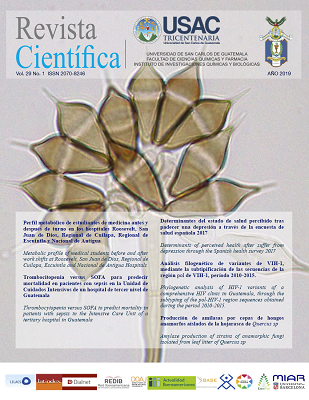Phylogenetic analysis of HIV-1 variants of a comprehensive HIV clinic in Guatemala, through the subtyping of the pol-HIV-1 region sequences obtained during the period 2010-2015
DOI:
https://doi.org/10.54495/Rev.Cientifica.v29i1.48Keywords:
HIV, HIV-1, subtyping, subtype BAbstract
The HIV genome contains nine genes, three of these genes (gag, pol and env) encoded for structural proteins. There are two main variants of this virus, HIV-1 and HIV-2. The first one (HIV-1) is the cause of most infections worldwide, of which nine subtypes and 58 circulating recombinant forms (CRF) have been identified. In Central America, subtype B of HIV-1 is the cause of the majority of HIV positive cases. In Guatemala, it has been reported the presence of subtype B, recombinant forms BF1 and subtype C. However, no phylogenetic analysis has been performed to indicate the variants of this subtype. The aim of the study was to subtype 400 sequences of the pol region of HIV-1 of samples that were obtained from a care clinic during the period 2010 to 2015. To determine the different subtypes of HIV-1 present in Guatemala, the subtyping of the sequences obtained by the genotype test in FASTA format was performed with REGA HIV-1 Subtyping Tool - Version 3.0. In order to determine the relationship between HIV-1 variants, an alignment of sequences and phylogenetic trees was performed using the Neighbor Union and Maximum Likelihood method with 100 bootstrap replicas, with the MEGA 7.0.21 program. It was determined that the subtypes with the highest prevalence of the studied sequences are the subtype B (71.5 %), recombinant BD (16.75%) and subtype B-like with (7.75 %).
Downloads
References
Arenas, M. (2015). Trends in substitution models of molecular evolution. Frontiers in Genetics, 6(319). https://doi.org/10.3389/fgene.2015.00319
Ávila-Ríos, S., Mejía-Villatoro, C. R., García-Morales, C., Soto-Nava, M.,Escobar, I., Mendizabal, R., … & Reyes-Terán, G. (2011). Prevalence and patterns of VIH transmitted drug resistance in Guatemala. Revista panamericana de salud pública, 30(6), 641-648. https://doi.org/10.1590/S1020-49892011001200024
Darriba, D., Taboada, G., Doalla, R., & Posada, D. (2012). jModelTest 2: more models, new heuristics and parallel computing. Nature methods9(8), 772. https://doi.org/10.1038/nmeth.2109
Delgado, R. (2011). Características virológicas del VIH. Enfermedades infecciosas y microbiológica clínica, 29(1), 58-65. https://doi.org/10.1016/j.eimc.2010.10.001
De Oliveira, T., Deforche, K., Cassol, S., Rambaut, A., & Vandamme, A. (2014). REGA HIV-1 Subtyping Tool - Version 3.0 [Software]. Recuperado de http://dbpartners.stanford.edu:8080/RegaSubtyping/stanford-hiv/typingtool/
Engelman, A., & Cherepanov, P. (2012). The structural biology of HIV-1: mechanistic and therapeutic insights. Nature reviews. Microbiology, 10(4), 279-290. https://doi.org/10.1038/nrmicro2747
Fauci, A., Kasper, D., Hauser, S., Longo, D., Jameson, L., & Loscalzo, J. (2008). Harrison Principios de medicina interna. México. D.F.: Mc GrawHill.
Kumar, S., Stecher, G., & Tamura, K. (2016). MEGA 7: Molecular Evolutionary Genetics Analysis Version 7.0 for Bigger Datadets. Molecular biology evolution, 33(7), 1870-4. https://doi.org/10.1093/molbev/msw054
Lahuerta, M. (2009). Epidemiología molecular y control de la transmisión vertical del VIH-1: En un área endémica de malaria del sur de Mozambique (Tesis doctoral). Universitat de Barcelona, España.
López, P., Rivera-Amill, V., Rodríguez, N., Vargas, F., & Yamamura, Y. (2016). The genetic diversity and evolution of HIV-1 subtype B epidemic in Puerto Rico. International journal of environmental research and public health, 13(1), 55. https://doi.org/10.3390/ijerph13010055
Murillo, W., Veras, N., Prosperi, M., Lorenzana, I., Paz, G., Morales, S., … & Salemi, M. (2013). A Single early introduction of VIH-1 subtype B into Central America accounts for most current cases. Journal of virology,87(13),7463-7470. https://doi.org/10.1128/JVI.01602-12
Pasquier, C., Millot, N., Njouom, R., Sandres, K., Cazabat, M., Puel, J., & Izopet, J. (2001). HIV-1 subtyping using phylogenetic analysis of pol gene sequences. Journal of virological methods, 94, 45-54. https://doi.org/10.1016/S0166-0934(01)00272-5
Pineda-Peña, A. C., Faria, N. R., Imbrechts, S., Libin, P., Abecasis, A. B., Deforche, K., … & Vandamme, A. M. (2013). Automated subtyping of HIV-1 genetic sequences for clinical and surveillance purposes: performance evaluation of the new REGA version 3 and seven other tools. Infection, genetics and evolution, 19, 337-348. https://doi.org/10.1016/j.meegid.2013.04.032
Programa Conjunto de las Naciones Unidas sobre el VIH/sida. (2017). HIV and AIDS Estimates. Guatemala. Recuperado de http://unaids.org/es/regionscountries/countries/guatemala
Ríos, M., Villanueva, C., San Martín, C., & Ramírez, E. (2003). Identificación de subtipos B y F de VIH-1 en pacientes chilenos. Revista médica de Chile, 131(7), 711-718. https://doi.org/10.4067/S0034-98872003000700001
Robertson, D., Sharp, P., McCutchan, F., & Hahn, B. (1995). Recombination in HIV-1. Nature,374(6518),124. https://doi.org/10.1038/374124b0
Silvestre, L. (2010). Infecciones de transmisión sexual en personas viviendo con VIH/SIDA con o sin tratamiento antirretroviral (Tesis de licenciatura). Universidad de San Carlos de Guatemala, Guatemala.
Taylor-Castillo, L., León-Bratti, M. P., Solano-Chinchilla, A., Herrera-Martínez, G., Boza- Cordero, R., León, B., … & Visoná, K. (2010). Variability in HIV-1 partial genomic sequences in Costa Rican patients: analysis with different bioinformatics tools. Revista Panamericana de Salud Pública, 27(1), 23-31. https://doi.org/10.1590/S1020-49892010000100004
Downloads
Published
How to Cite
Issue
Section
License
Copyright (c) 2019 Ana Oliva-Castillo, Dalia Lau-Bonilla

This work is licensed under a Creative Commons Attribution 4.0 International License.
Authors who publish with this journal agree to the following terms:
- Authors retain copyright and grant the journal right of first publication with the work simultaneously licensed under a Creative Commons Attribution License 4.0 that allows others to share the work with an acknowledgement of the work's authorship and initial publication in this journal.
- Authors are able to enter into separate, additional contractual arrangements for the non-exclusive distribution of the journal's published version of the work (e.g., post it to an institutional repository or publish it in a book), with an acknowledgement of its initial publication in this journal.
- Authors are permitted and encouraged to post their work online (e.g., in institutional repositories or on their website) prior to and during the submission process, as it can lead to productive exchanges, as well as earlier and greater citation of published work.









